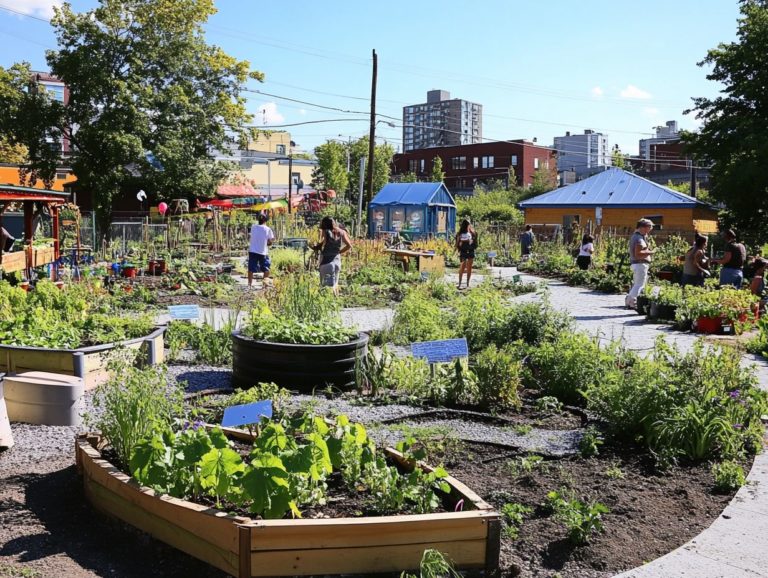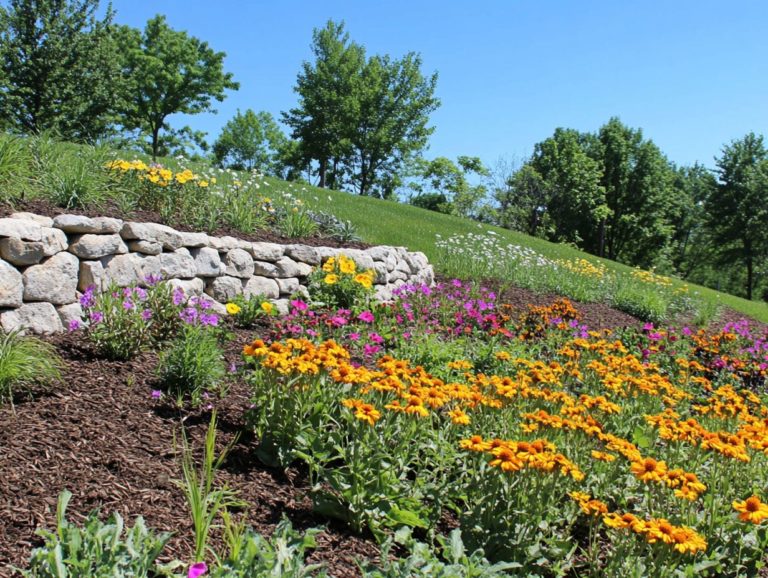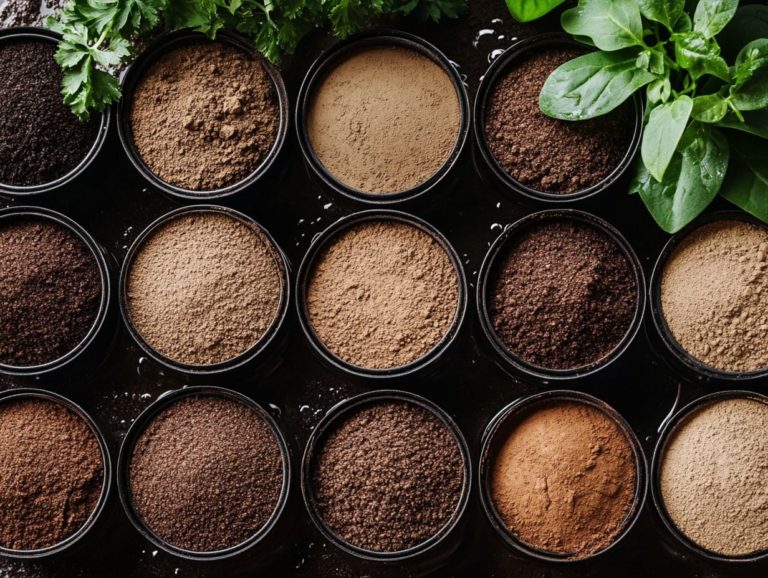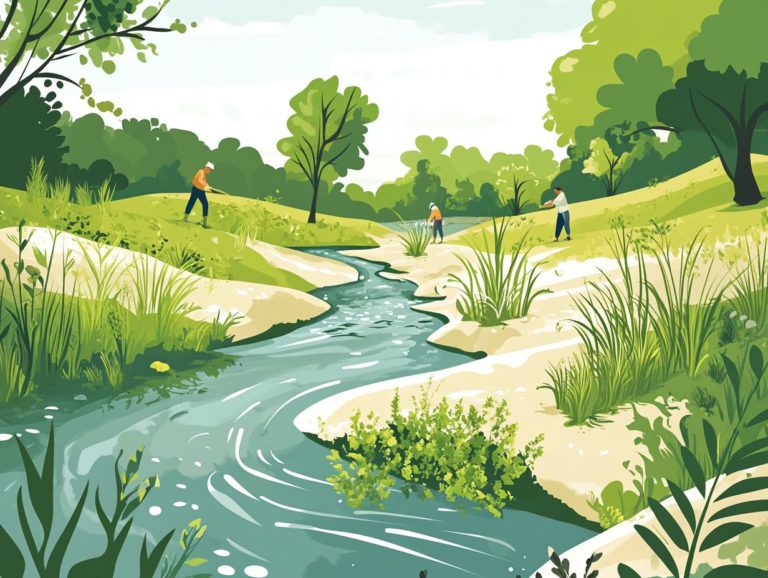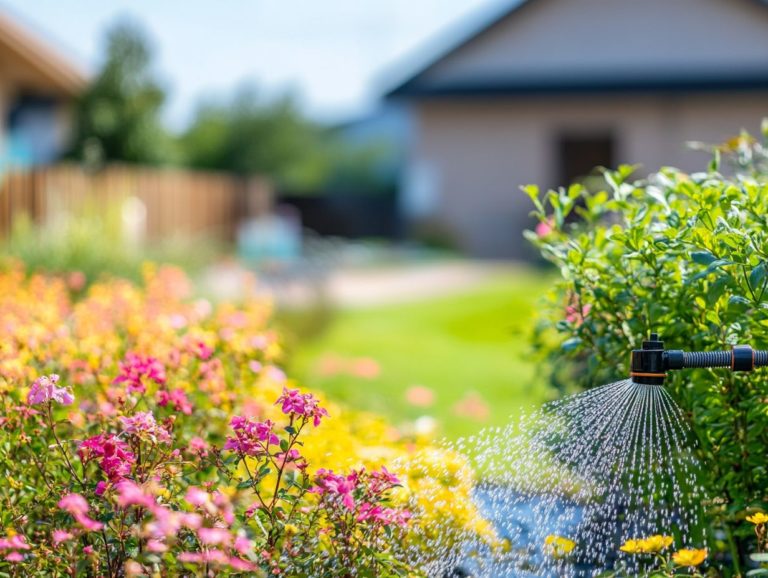The Role of Mulching in Water Conservation
Water conservation is vital in today s evolving climate. One of the most effective strategies to achieve this is through mulching.
This exploration emphasizes the importance of both water conservation and mulching in your gardening practices and landscaping endeavors. By utilizing organic mulch, you can significantly reduce water evaporation, enhance moisture retention, and effectively suppress weed growth.
You ll also discover the various types of mulch available, along with practical tips for application and maintenance ensuring your garden remains vibrant and water-efficient.
Discover how mulching can transform your garden and make it more sustainable!
Contents
- Key Takeaways:
- Understanding Water Conservation and Mulching
- The Benefits of Mulching for Water Conservation
- Types of Mulch for Water Conservation
- Using Mulch to Save Water
- Tips for Maintaining Mulch and Conserving Water
- Frequently Asked Questions
- 1. What is the purpose of mulching in water conservation?
- 2. How does mulching help prevent soil erosion?
- 3. What types of mulch are best for water conservation?
- 4. Can mulching help to reduce weed growth?
- 5. Is there a best time to apply mulch for water conservation?
- 6. How does mulching benefit the overall health of plants?
Key Takeaways:
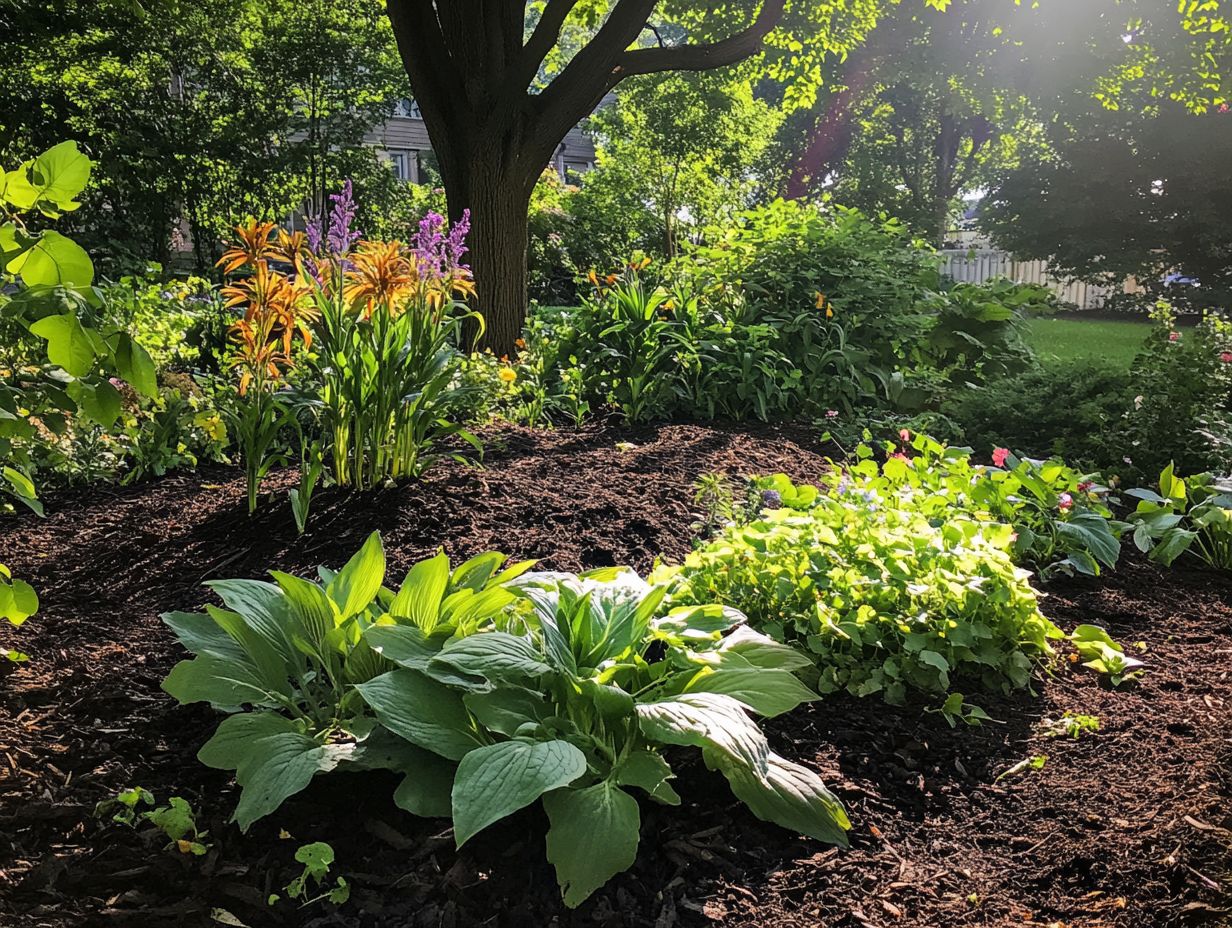
- Mulching can significantly contribute to water conservation by reducing water evaporation, improving soil moisture, and suppressing weed growth.
- There are two main types of mulch – organic mulch and inorganic materials – and choosing the right one for your garden is crucial for maximum water conservation.
- Proper mulch application and maintenance of mulch, such as replenishing and monitoring soil moisture, can further enhance its role in water conservation efforts.
Understanding Water Conservation and Mulching
Grasping the principles of water conservation and mulching is vital for your gardening and agricultural success. These practices improve the soil, boost crop yield, and align perfectly with sustainable gardening techniques.
Mulching serves a dual purpose: it retains moisture in the soil and regulates temperature both critical factors for nurturing your crops. By embracing eco-friendly methods (methods that are good for the environment), like using organic mulch, you can cultivate a vibrant soil ecosystem that supports robust crop production while minimizing your environmental footprint.
The relationship between mulching and water conservation is crucial in contemporary agricultural management.
Defining Water Conservation and Mulching
Water conservation is all about using and managing your water resources efficiently to prevent waste and ensure that there’s enough for future generations. On the other hand, mulching involves covering your soil with various mulch materials to enhance its health and retain moisture.
These practices are essential in modern gardening and agriculture, as they not only help save precious water but also promote the overall well-being of the soil ecosystem. By incorporating organic materials like straw, grass clippings, and bark into your mulching routine, you can significantly improve soil fertility and structure, providing vital nutrients to your crops.
Mulching also minimizes evaporation and suppresses weed growth, creating a nurturing environment for your plants. This focus on better soil health translates into higher crop yields, making these techniques invaluable for sustainable farming practices and conservation efforts.
The Benefits of Mulching for Water Conservation
The benefits of mulching for water conservation are numerous. It effectively aids in moisture retention, suppresses weeds, and regulates temperature all essential factors that contribute to the overall health of the soil and enhance crop yield.
Act now and see the benefits of mulching! It aids in moisture retention and creates a flourishing environment for your plants while conserving precious water resources.
Reducing Water Evaporation
Reducing water evaporation is one of the standout benefits of mulching. By laying down a protective layer, you effectively limit moisture loss from the soil, ensuring your crops have a steady supply of water.
This process works through various mechanisms, like creating a barrier that shields the soil surface from the relentless assault of direct sunlight and wind. You can opt for organic materials such as straw, wood chips, or grass clippings. Each offers unique levels of insulation and moisture retention.
Take straw, for example. It not only breaks down over time, enriching your soil with vital nutrients, but it also helps lower soil temperature crucial for optimal crop growth.
On the flip side, inorganic options like plastic sheeting reflect sunlight, reduce weed growth, and foster a more favorable microclimate for your plants.
These mulch materials are invaluable allies in your water conservation efforts, enabling you to cultivate healthier and more productive crops.
Improving Soil Moisture Retention
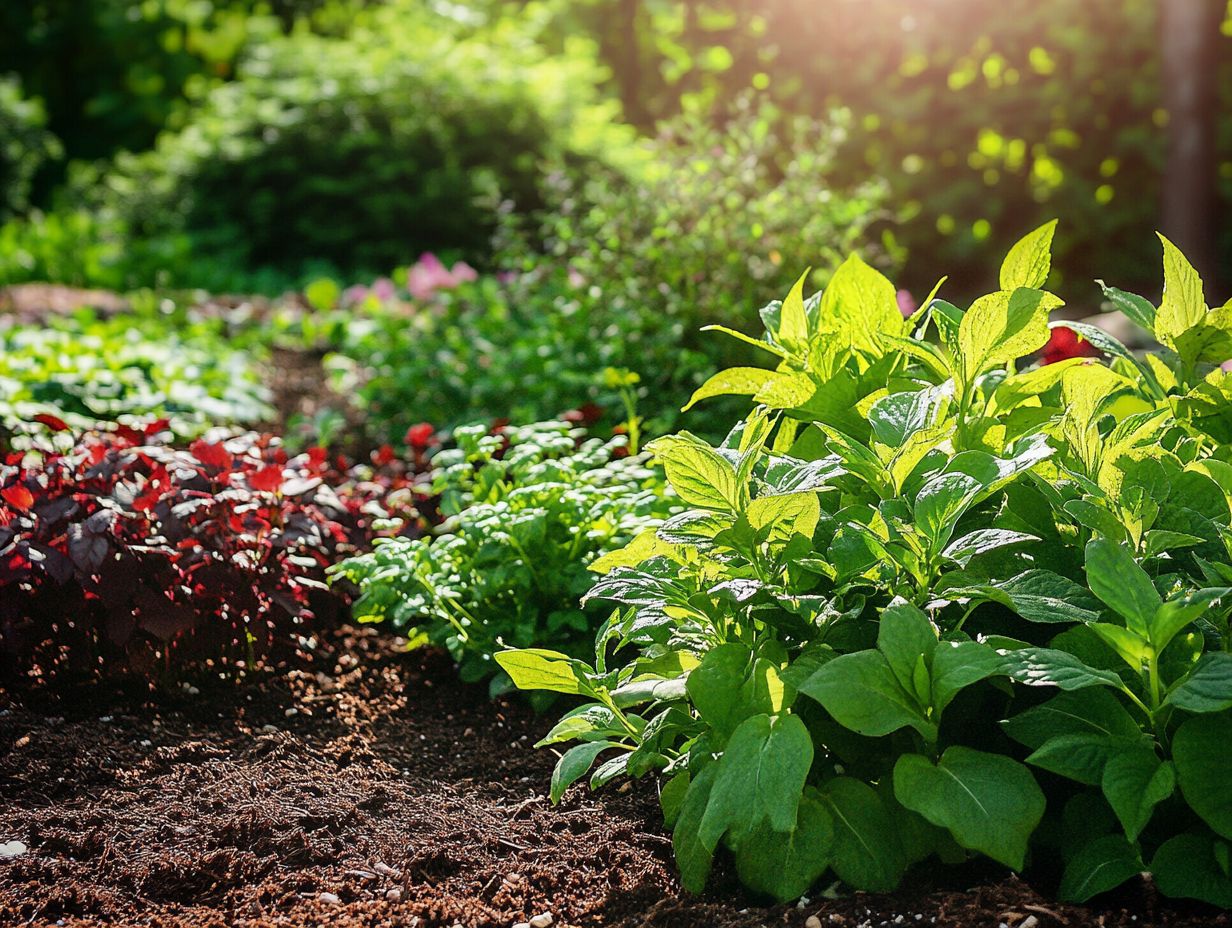
Improving soil moisture retention is another standout benefit of mulching. As organic mulch materials break down, they help the soil and significantly increase its ability to hold moisture.
This process also cultivates a welcoming environment for beneficial microorganisms, or helpful tiny organisms that improve soil health. When considering the various types of mulch, straw and wood chips emerge as popular organic choices.
For example, straw excels at retaining moisture while simultaneously suppressing weeds, earning high marks for its functionality.
On the other hand, inorganic mulches like gravel and landscape fabric also contribute to moisture retention, albeit without enhancing soil health in the same manner.
Landscape fabric, in particular, is highly effective at reducing evaporation, making it a valuable option for gardens that endure prolonged dry spells.
Suppressing Weed Growth
Suppressing weed growth is one of the standout advantages of mulching. By blocking sunlight from reaching pesky weed seeds and seedlings, you re not just helping your crops thrive; you re also fostering better soil health.
This technique reduces competition for vital nutrients, creating a flourishing ecosystem beneath the surface. You can use organic materials like straw, wood chips, and grass clippings to create a barrier that keeps weeds at bay while enriching the soil.
The interplay between effective weed control and enhanced soil health can lead to impressive crop yields. This allows your plants to access essential resources without the hassle of invasive growth.
Embracing the right mulching practices not only supports your individual crops but also aids in the long-term sustainability of your agricultural systems.
Types of Mulch for Water Conservation
Explore a variety of mulch options that can make a real difference in conserving water! Each offers its own distinct properties and benefits.
Consider organic mulch, which not only conserves moisture but also enriches the soil over time. Alternatively, inorganic materials provide a durable solution, enhancing the aesthetic appeal of your landscape while maintaining functionality.
Organic vs. Inorganic Mulch
Organic mulch, crafted from materials like wood chips, straw, or leaves, enhances soil health and boosts moisture retention. In contrast, inorganic materials, such as plastic mulch, offer long-lasting coverage but fall short in improving soil quality over time.
The choice between these two mulch types profoundly affects both the aesthetic appeal of your garden and its ecological balance. Organic mulch enriches the soil by introducing nutrients and fostering beneficial microbial activity as it breaks down.
While inorganic mulch excels at preventing weeds and stabilizing soil temperatures, it can lead to challenges such as increased water runoff and diminished soil aeration.
Consequently, the long-term effects on soil health vary significantly. Organic options typically nurture the ecosystem in the long run, while inorganic alternatives may offer short-term benefits accompanied by potential drawbacks.
Choosing the Right Mulch for Your Garden
Choosing the right mulch for your garden involves thoughtful consideration of several factors, such as the type of plants you have, your local climate, and the moisture retention techniques you’d like to employ to enhance soil structure and health.
By evaluating these elements, you can create the best environment for your plants to thrive. For example, colorful wood chips can beautifully enhance ornamental gardens. On the other hand, straw or grass clippings can be a boon for vegetable patches, enriching nutrient content as they decompose.
It’s also essential to use the right gardening tools, like shovels and rakes, during the application process. This ensures an even layer of mulch that effectively locks in moisture. This uniform application helps prevent weed growth and plays a critical role in water conservation a vital consideration for sustainable gardening practices.
Using Mulch to Save Water
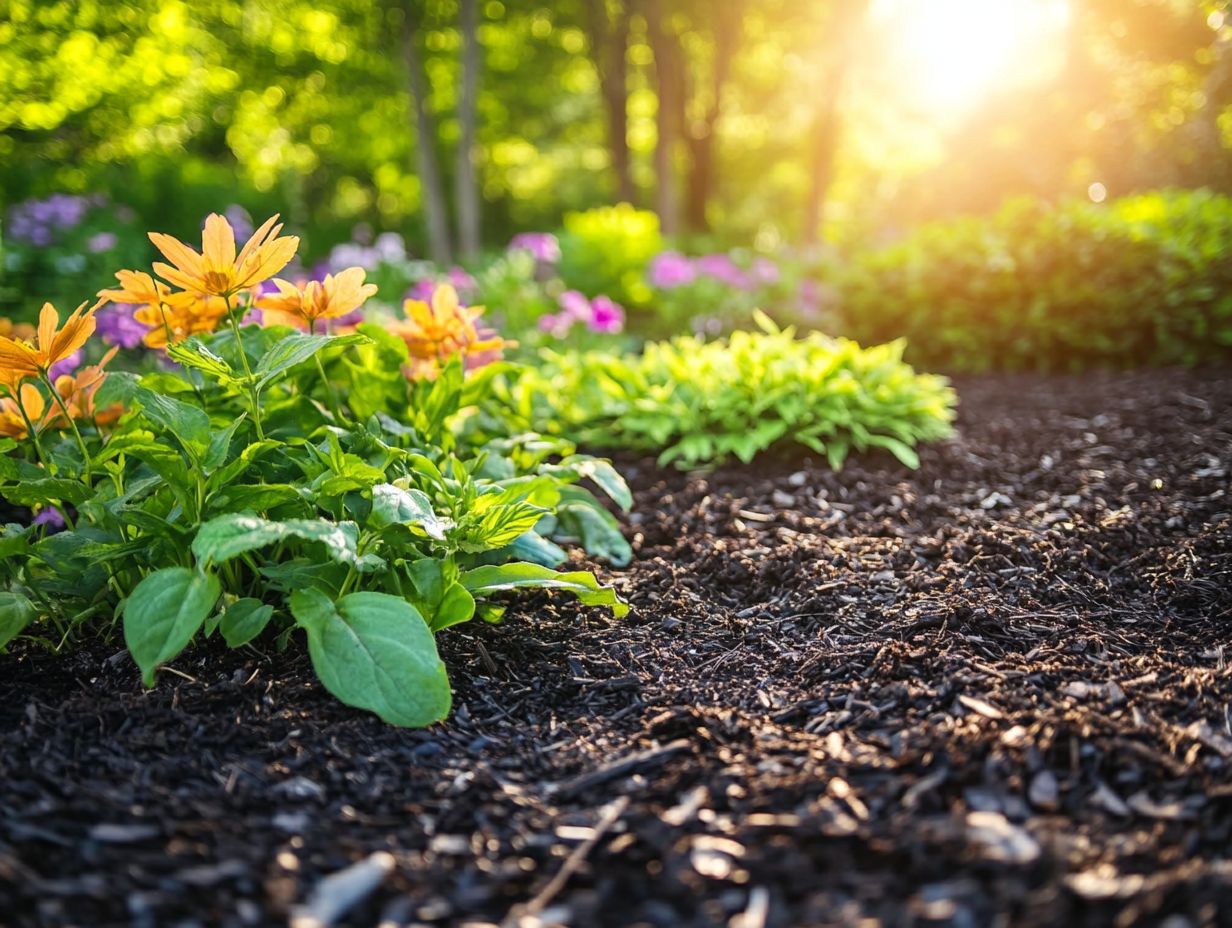
Using mulch for water conservation requires a good understanding of how to apply it. Mastering these methods is essential for maintaining soil moisture and maximizing the efficiency of your irrigation practices.
Proper Application Techniques
Proper application techniques for mulch are essential for maximizing its benefits. You ll want to ensure even coverage, maintain the appropriate depth, and select the right timing to optimize moisture retention and promote healthy crop growth.
Want the best results? Here s how! Consider the type of mulch that complements your soil and plant varieties. Organic materials such as wood chips or straw can significantly enhance soil health as they break down. Aim for a mulch depth of two to four inches; this range will promote adequate moisture retention while effectively curbing weed growth.
Timing matters as well. Applying mulch in the spring, once the soil has warmed up, allows for its optimal benefits. Be sure to avoid direct contact with plant stems to prevent rot and disease, setting the stage for healthier, more robust plants.
Tips for Maintaining Mulch and Conserving Water
Effectively maintaining mulch is crucial for conserving water. By regularly replenishing it and monitoring soil moisture levels, you can significantly enhance both the longevity and effectiveness of mulch in your garden.
Replenishing Mulch and Monitoring Soil Moisture
Replenishing mulch and monitoring soil moisture are essential practices for maintaining an effective mulching system, ensuring that your plants receive optimal water and nutrients throughout their growing cycles.
Regularly adding a fresh layer of mulch not only helps retain moisture but also keeps pesky weeds at bay, preventing them from competing for vital resources. It s crucial to keep an eye on the moisture levels beneath the mulch since both excessive dryness and saturation can jeopardize your plants’ health. A practical strategy would be to use a soil moisture meter, giving you an accurate gauge of the moisture content.
Checking the mulch depth, ideally between two to four inches, helps create the perfect barrier for the soil beneath. This proactive maintenance nurtures healthy root systems and vibrant plant life, aligning beautifully with your goals of sustainable gardening practices.
Frequently Asked Questions
1. What is the purpose of mulching in water conservation?
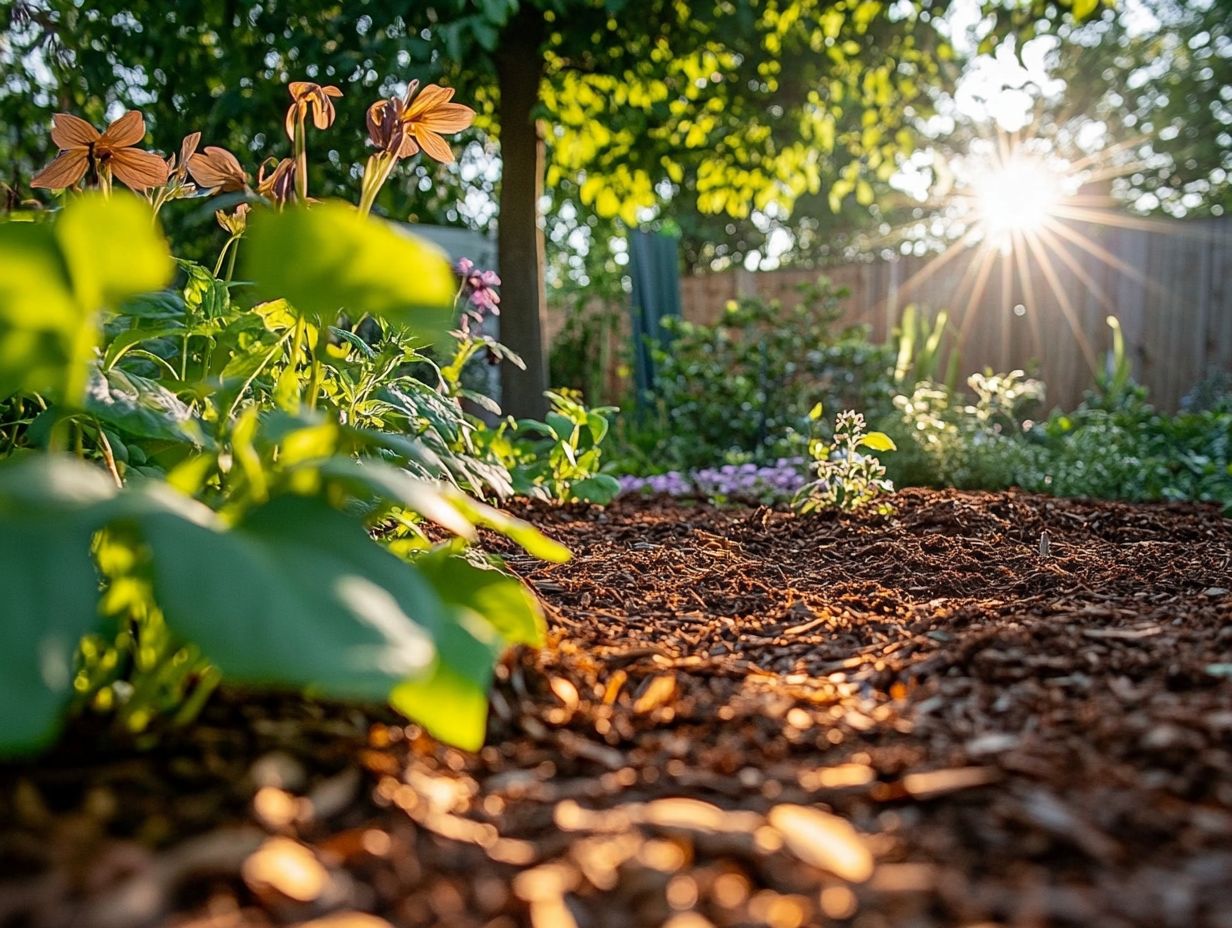
Mulching helps to retain moisture in the soil, reducing the need for frequent watering. This conserves water and promotes plant growth.
2. How does mulching help prevent soil erosion?
Mulch acts as a protective layer on top of the soil, preventing water runoff and reducing the impact of heavy rain on the soil. This helps prevent soil erosion and loss of valuable topsoil.
3. What types of mulch are best for water conservation?
Organic mulches, such as wood chips, straw, or shredded leaves, are the most effective for water conservation. They retain moisture and also add nutrients to the soil as they break down.
4. Can mulching help to reduce weed growth?
Yes, mulching blocks sunlight and stops weed seeds from growing. This reduces manual weeding and conserves water by limiting competition for moisture.
5. Is there a best time to apply mulch for water conservation?
Apply mulch in the spring before the hot summer. This keeps soil moisture levels stable and cuts down on frequent watering.
6. How does mulching benefit the overall health of plants?
Mulching regulates soil temperature and reduces compaction. It also provides nutrients to help plants thrive and become stronger.

